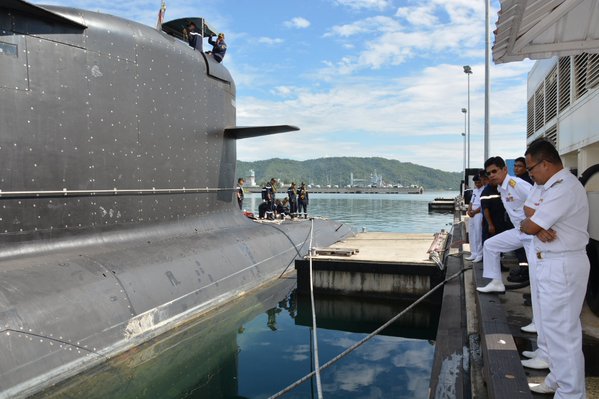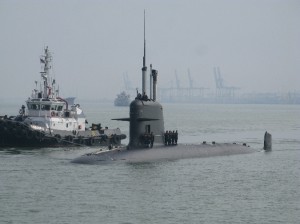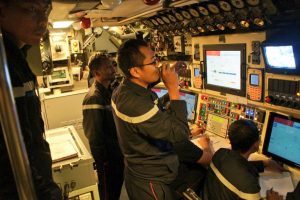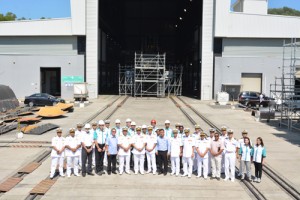
SHAH ALAM: A Magnetic Ranging and Deperming Facility will be built at the Kota Kinabalu naval base in Teluk Sepanggar, Sabah. The MRDF contract was awarded to DCNS of France, the JV builder/maintainer of RMN submarines and the sub-contractor for the LCS.
The MRDF will provide countermeasures for RMN ships and submarines against magnetic mines. It will also reduce the chance of RMN submarines being detected using magnetic anomaly detection (MAD) equipment. A more detail explanation from Wikipedia.
“A sea-going metal-hulled ship or submarine, by its very nature, develops a magnetic signature as it travels, due to a magneto-mechanical interaction with Earth’s magnetic field. It also picks up the magnetic orientation of the earth’s magnetic field where it is built. This signature can be exploited by magnetic mines or facilitate the detection of a submarine by ships or aircraft with magnetic anomaly detection (MAD) equipment. Navies use the deperming procedure, in conjunction with degaussing, as a countermeasure against this.”
The contract with DCNS was announced in a press release issued by TLDM on its website on Aug 9. It did not state the cost of the contract or when it was signed. I am assuming that the contract is an offset obligation for the Perdana Menteri-class refit program, first announced in Nov 15, 2015.

“In a statement, BHIC told Bursa Malaysia that Boustead DCNS Naval Corp Sdn Bhd, a 60:40 JV between BHIC’s unit BHIC Defence Technologies Sdn Bhd and DCNS SA, had received and accepted a letter of acceptance (LOA) from the Government at a total dual currency contract price of 169.859 million euros (RM799.28mil) and RM432.404mil (inclusive of goods and services tax)

For the full story go here. The contract was publicly signed at DSA 2016.
According to the RMN release, the new facility will be built at Pulau Udar, located inside the naval base. The MRDF according to the release will replacing the degaussing facility currently located at the Lumut Naval base. The facility at Lumut, is only able to conduct degaussing for ships.

Meanwhile, the refit for KD TAR is continuing. As the contract call for the refit to be completed in 18 months, the submarine is expected to be ready for deployment late next year.
— Malaysian Defence
If you like this post, buy me an espresso. Paypal Payment



The refit left us with only one unit of submarine to cover the entire EEZ
Hopefully all clear-minded malaysian could see how seriously we need more subs.
How many subs TLDM need? How big the logistic & resources can we affort to meet that many subs? MRDF brand new both for subs & surface vessels to be up at KK but no mention about the current one in Lumut. Someone commented here before, the Lumut’s facility is broken.
Reply
Three is good, four is perfect for practical reasons. One on patrol, one on standby limited patrol, one in training/standby and one in refit. As for the actual military requirements I have no idea. I think the degaussing system in Lumut is a mobile one
Is the 15 to 5 plan approved by malaysia government???Any update on it as well?
Reply
Not yet.
The German constructed de-gaussing centre in Lumut was refurbished about 10 years ago by a Brit company. Having a new de-gaussing range at Teluk Sepanggar is fine but the problem is that modern mines tend not to be magnetic but ”smart” and hard to detect; especially ones with casings that make it next to impossible for sonar to detect. The bad news is that rocket propelled mines are also available as are mines that are programmed to destruct upon detection of a particular acoustic signature – none are magnetic.The bad news is that like many, many other navies, the RMN’s main means of MCM remains the magnetic/wire sweep. The RN [after almost 80/90 years] has done away with the wire sweep and like the USN is focusing more on robotics to deal with new generation ”smart mines”. Granted there are many magnetic moored mines stocked by various regional navies but there are also newer mines out there.
Some may have missed the point but all the infrastructure work [battery support facilities, maintenance areas, etc] being done at Sepanggar means that the RMN will have the needed shore support infrastructure when the time comes to get additional boats. No point getting additional boats if the shore support infrastructure is not there; the RMN has got it right and is clearly thinking ahead.
ZekMR – ”Hopefully all clear-minded malaysian could see how seriously we need more subs.”
The RMN can make a very compelling case to justify why cash should be allocated for additional boats. The problem is the RMAF can do the same to justify funds for MRCAs and additional surface search radars. The army can say that it has stuff that’s been on its wish list for a decade. So what should be the priority? Given that there’s limited cash and that we’re not in a state of tensions with anyone; we have to prioritise and make trade offs.
These “smart mines” one way to beat them is utilising ROV and AUV, not to forget the frogmen, I believe TLDM have these 3 while keeping the wire sweep just in case it faced the “classic mines”. Significant investment is needed if we go for robotics or air-borne minesweeping.
Good to know that shore support infrastructure is there to cater for additional boats. Hope that sooner or later, the boats can launch land attack missiles and lay mines.
I think given the current state of affairs in the SCS, the navy comes first. Our allies, (UK, Aus and even US) will be more than willing to lend air support as long as there are no ‘boots on the ground’.
Off topic. On Border Regiment in Sarawak. Recruit training for the Regiment is ongoing in PLKN camps, AFAIK 1 in Kuching, another in Sibu. All this while I thought they 1st go to Port Dickson then deployed, thinking that PLKN camps are for add-on “Borderer” training. IMHO this setup put less strain on Army basic training center.
Reply
Much cheaper too. They don’t have to pay to send the recruits to PD. And at the same time helped out the PLKN camp operators whose livelihood are at stake as the program has been reduced drastically.
Nimitz,
Divers are used to attach charges to mines and sometimes to ID them but first the mines have to be detected. Sometimes the mine can be detonated by firing at it, this option is often used on drifting mines which can be spotted visually. If mines are laid in deep waters and are in casings that sonar can’t detect, then obviously it’s a huge problem. If a mine can destruct upon hearing your acoustic signature, way before you detect it, then it’s also a huge problem. Robotics are the way to go as they have more utility than ROVs.
2 main issues with ROVs are battery life and strong currents. The main problem is that our main means – same goes with the majority of navies – of dealing with mines is with the traditional wire sweep; used to cut the cables of moored mines.
Mines detection is a big challenge, while wire sweep is a hit-and-miss technique. Long after WWII, European still stumbled upon mines on their shores and in their waters. Swarming AUVs that mimics our own acoustic&magnetic signals looks like a way to kill mines while putting manned vessel out of harms way. Smart mines tuned only to adversary’s signatures will act as a passive defensive line while giving some manoevering room to own forces.
Interesting this mine warfare. Developing our own smart mines and deployed it smartly together with dumb mines in our relatively shallow seas, will delay or restrict movement of adversary surface task force.
Reply
Yes but people tend to gravitate to simpler stuff as thats where the money is . R&D is just lip service
Nimitz,
The wire sweep is certainly not a ”hit-and-miss technique”. It’s utility has been proven countless times; since WW1 in fact. Nowadays with GPS, it’s very precise. Unfortunately it is time consuming [on the sweep deck the cutters, floats, charges and paravane have to be attached manually then manually reeled out] and is only good against certain mines.
The mines that went adrift could be because accurate fixes were not taken when laid or because they broke away from their moorings and floated or were carried away by currents. Mines are often neglected as people tend to focus on the more sexy missile but mines are cheaper to buy and maintain and are stockpiled in large numbers. Unlike a missile, a mine detonated below the keel will break the back of a ship. Mines also can be laid by any ship – commercial or naval – with railings.
The Mahamiru class could well turn out to be the last dedicated MCMVs in RMN service. Given that MCMVs are expensive to build [compared to frigates or other ships; due to their construction] and that MCMVs have very little peacetime utility; I won’t be surprised if the next step for the RMN will be to get mine hunting and sweeping modules that can be retrofitted to other naval ships or even commercial ones. When it entered service the Mahamiru class was considered one the best MCMVs money could buy and gave us an unchallenged MCMV capability in the region for many years.
MRDF in a sub base, a speculation on my part, primarily to reduce sub magnetic signature, after magnetic mines threat become apparent then surface vessel have to come for treatment more frequently.
Local commercial boats that is small, non ferrous and in high numbers for minesweeping duties are the fishing trawlers. Hope that TLDM take these trawlers into consideration when the time comes to get a MCM modules in the future.